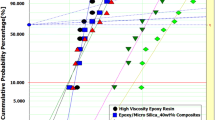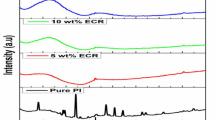Abstract
In this study, the particle reinforced epoxy composite with alumina and silica was considered to insulation material for the gas insulated switchgears (GIS). The single (alumina or silica) and mixed particle (alumina-silica) reinforced epoxy composites were fabricated to investigate the mechanical properties according to the content of the particles. The material properties of the alumina reinforced composites showed rapid decreasing behavior at the particle content of 40 wt% and slowly recovered. Whereas, the case of the silica did not show the severly decreased mechanical properties at the same particle content compare to the alumina. The mechanical properties of the mixed particle reinforced composites showed the increasing with the silica content and the effect of the particle reinforced epoxy composite system was evaluated to be greater for silica than alumina. Therefore, the proper use of mixing of alumina and silica particles was assessed to be effective in improving manufacturing and material properties in epoxy composite.
Similar content being viewed by others
References
J. Hao, C. Liu, Y. Li, R. Liao, Q. Liao and C. Tang, Preparation nano-structure polytetrafluoroethylene (PTFE) functional film on the cellulose insulation polymer and its effect on the breakdown voltage and hydrophobicity properties, Materials, 11(5) (2018) 851–865.
S. H. Mahdi, W. H. Jassim, I. A. Hamad and K. A. Jasima, Epoxy/silicone rubber blends for voltage insulators and capacitors applications, Energy Procedia, 119 (2017) 501–506.
R. Raja Prabu, S. Usa, K. Udayakumar, M. Abdullah Khan and S. S. M. Abdul Majeed, Electrical insulation characteristics of silicone and EPDM polymeric blends, IEEE Transactions on Dielectrics and Electrical Insulation, 14(5) (2007) 1207–1214.
T. Andritsch, A. Vaughan and G. C. Stevens, Novel insulation materials for high voltage cable systems, IEEE Electrical Insulation Magazine, 33(4) (2017) 27–33.
R. Sarathi, R. K. Sahu and P. Rajeshkumar, Understanding the thermal, mechanical and electrical properties of epoxy nanocomposites, Materials Science and Engineering: A, 445–456 (2007) 567–578.
N. Hayakawa, H. Maeda, S. Chigusa and H. Okubo, Partial discharge inception characteristics of LN2/epoxy composite insulation system under thermal bubble condition, Cryogenics, 40(3) (2000) 167–171.
G. Iyer, R. S. Gorur, R. Richert, A. Krivda and L. E. Schmidt, Dielectric properties of epoxy-based nanocomposites for high voltage insulation, IEEE Transactions on Dielectrics and Electrical Insulation, 18(3) (2011) 659–666.
M. Amin, M. Ali and A. Khattak, Fabrication, mechanical, thermal, and electrical characterization of epoxy/silica composites for high-voltage insulation, Science and Engineering of Composite Materials, 25(4) (2017) 753–759.
M. Arefi, E. M. R. Bidgoli, R. Dimitri, M. Bacciocchi and F. Tornabene, Nonlocal bending analysis of curved nanobeams reinforced by graphene nanoplatelets, Compo. B. Eng., 166(1) (2019) 1–12.
M. M. H. Mirzaei, M. Arefi and A. Loghman, Creep analysis of a rotating functionally graded simple blade: Steady state analysis, Steel Compo. Struc., 33(3) (2019) 463–472.
M. M. H. Mirzaei, M. Arefi and A. Loghman, Time-dependent creep analysis of a functionally graded simple blade using first-order shear deformation theory, Aust. J. Mech. Engi. (2019) 1–13.
M. M. H. Mirzaei, M. Arefi and A. Loghman, Thermoelastic analysis of a functionally graded simple blade using first-order shear deformation theory, Mech. Adv. Compos. Struct., 7(1) (2019) 147–155.
P. O. Henk, T. W. Kortsen and T. Kvarts, Increasing the electrical discharge endurance of acid anhydride cured DGEBA epoxy resin by dispersion of nanoparticle silica, High Performance Polymers, 11(3) (1999) 281–296.
Z. Farhadinejad, M. Ehsani, S. Moemen-bellah, S. M. B. Alavi, M. M. Shrazi and H. Borsi, An investigation of the effect of nano alumina on the electrical and thermal properties and morphological behavior of the cast epoxy nano composite, 17th International Symposium on High Voltage Engineering, Hannover, Germany (2011) 22–26.
T. Imai, F. Sawa, T. Nakano, T. Ozaki, T. Shimizu, M. Kozako and T. Tanaka, Effects of nano- and micro-filler mixture on electrical insulation properties of epoxy based composites, IEEE Transactions on Dielectrics and Electrical Insulation, 13(2) (2006) 319–326.
J. J. Park, C. H. Lee, J. Y. Lee and H. D. Kim, Preparation of epoxy/micro- and nano- composites by electric field dispersion process and its mechanical and electrical properties, IEEE Transactions on Dielectrics and Electrical Insulation, 18(3) (2011) 667–674.
B. K. Sarkar, Estimation of composite strength by a modified rule of mixtures incorporating defects, Bulletin of Materials Science, 21(4) (1998) 329–333.
Author information
Authors and Affiliations
Corresponding author
Additional information
Recommended by Editor Chongdu Cho
Joo-Eon Park is a Senior Researcher of ICT Research Department at Hyundai Electric & Energy Systems Co., Ltd., Korea. He received the B.Eng. degree in Robot System Engineering from Tongmyong University, Korea in 2006. He received the M.Eng. degree in Mechanical Engineering from Hanyang University, Korea in 2008. He received the Ph.D. degree in Molecular and Material Science from Kyushu University, Japan in 2011. His research interests are material design of engineering plastics and reliability diagnosis of composite materials.
Bok-Yeol Seok is a Professor of the Department of Electrical Engineering at Daelim University College, Korea. He received the B.Eng. and M.Eng. degrees in Electrical Engineering from Busan National University, Korea in 1994 and 1996, respectively. He received the Ph.D. degree in Electro and Electric Systems Engineering from Kyushu University, Japan in 2000. His research interests are high voltage phenomena and insulation design of high voltage electric power apparatus.
Rights and permissions
About this article
Cite this article
Park, JE., Seok, BY. Mechanical properties of inorganic particle reinforced epoxy composites for gas insulated switchgear. J Mech Sci Technol 34, 2795–2799 (2020). https://doi.org/10.1007/s12206-020-0612-7
Received:
Revised:
Accepted:
Published:
Issue Date:
DOI: https://doi.org/10.1007/s12206-020-0612-7




